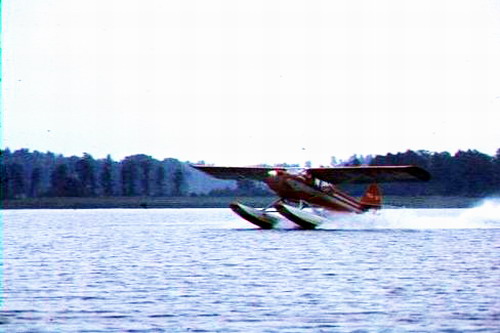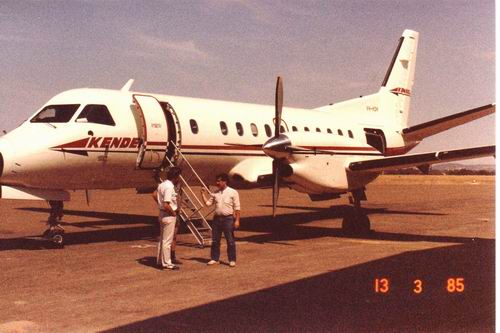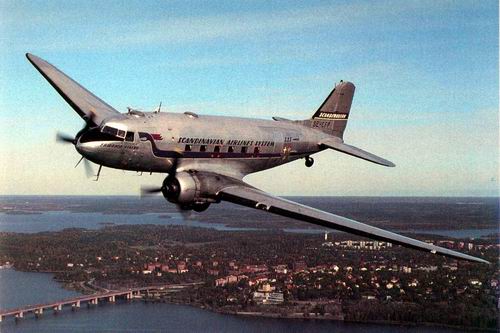|
 |
This is a SAAB 91. It was the first aircraft I flew. This happened
in 1962 at the Swedish Air Force pilot training school at Ljungbyhed in
southern Sweden. I got some 80 hours on this aircraft before they sent
me on to jet trainers. This aircraft was called SK50 in the Air Force
and existed in several versions. An exhaustive description can be found
at this website:
http://www.fcfk.com/safir/ |
| I got a civilian license as soon as I could and then got checked out
on the Piper
Colt. I first flew one at the Ljungbyhed Flying Club and later
impressed all my classmates and friends back in northern Sweden by
flying this aircraft out of Midlanda airport just south of Härnösand,
where I was born. Ref: Piper PA-22 Colt, SE-CRK, c/n
22-9081-931 |
 |
|
 |
After 80 hours on the SAAB 91 the Air Force sent me on to the De
Havilland Vampire jet trainer. We got some 5-7 hours in the two-seater
and were then sent on to fly the single seater fighter version. |
|
 |
It was a very exciting day, when my instructor, Flight Officer Teemu
Värälä, told me to go and fly the single seater version of the Vampire.
We usually flew it without the wing tanks and the fuel system was
designed with individual indicators for the fuel tanks, inboard and
outboard, so you had to do
a lot of mental arithmetic to decide your fuel remaining. You can read
more about this aircraft here:
http://www.answers.com/topic/de-havilland-vampire and
http://www.vampirepreservation.org.uk/ Link courtesy of
Captain Tom Ehnert. |
| After a year at the Air Force flying school I was sent to the base
in Söderhamn, F15, where I got checked out on the A32 Lansen. This was a
SAAB built low level attack aircraft that usually carried a navigator in
the back seat. You can read more about it here:
http://www.canit.se/~griffon/aviation/text/32lansen.htm |
 |
|
 |
This picture is showing an A32 on display at the Air Force
museum. |
| My two SAABs. The one in the foreground is a brand new SAAB 96 that
I bought in the spring of 1964. In the background an A32 Lansen landing
at RW31 at F15 in Söderhamn. |
 |
|
 |
While based in Söderhamn, I also checked out on the J3 Cub on skies
at Mohed Flying Club. The picture is showing a similar aircraft at the
Ljungbyhed Flying Club. |
| At F15 we were also trained on the North American Harvard/T6 Texan.
These aircraft had been used at advanced trainers in the Swedish
Airforce, but had been distributed out to the different bases when they
were replaced by more modern trainers. The picture here is showing an
aircraft belonging to a former Eva Air captain, Ken Walker from New
Zealand. More information on the Harvard here:
http://www.spitcrazy.com/harvard.htm |
 |
|
 |
In 1964 I was transferred to the Air Force Academy at
F20 in Uppsala, just north of Stockholm. The flight duty there was done on the
SAAB J29F.
Link:
http://www.fighter-planes.com/info/j29.htm |
| At the end of 1964 I left the Air Force and joined Scandinavian
Airlines, but was offered an opportunity to do Air Force duty at F3 in
Linköping where I flew the J29F and the S29C whenever I could get time
off from SAS.. |
 |
|
 |
My first aircraft in SAS was the Sud Aviation SE210 Caravelle. We
operated all over Europe and occasionally also to the Middle East. SAS
Flight Academy had a SE-210 systems procedure trainer and I was
pleasantly surprised when I saw this old box at the Technical Museum in
Stockholm last year. Link:
http://www.geocities.com/capecanaveral/lab/8803/fcaravel.htm |
|
 |
In June, 1957, SAS became the first airline outside
France to order the Sud Aviation Caravelle. Six aircraft were ordered.
Caravelle introduced the jet age in SAS on April 26, 1959. Eventually,
SAS had 21 Caravelle aircraft in its fleet, and the popular aircraft
served SAS honorably for more than 10 years. |
| In 1967 I transferred to the DC-8. SAS operated -33, -55F, -62 and
-63 versions. They became the standard long-haul aircraft and we flew it
to Greenland, Asia, United States and Canada, Africa and South America. |
 |
 |
This picture shows a DC-8 landing at Söndre Strömfjord in Greenland.
Initially Söndre Strömfjord was used as a refueling stop on the
Copenhagen-Los Angeles route, but when the DC-8-62 was introduced, this
stopped, since this aircraft had enough range to fly non-stop. I was
based in Bangkok to fly Bangkok-Tashkent in 1967 and then again 1969 to
1971 to fly Manila, Singapore, Jakarta, Calcutta, Karachi and the
occasional Copenhagen flight. In 1975 I was based in Tokyo and Anchorage
for several periods. I came back to the DC-8 in 1987, now working the
left seat as an instructor pilot. We flew mostly charter operations for
Scanair and the occasional flight to Thule, Greenland for SAS |
| SAS was the largest DC-9 operator in the world outside the US. We
had -21, -33F and -41. Later SAS got a lot of MD-80s as well. I was
assigned to the DC-9 as a co-pilot in 1971-1974 and later in 1980-1987
I flew DC-9/MD-80 from the left seat.. The most
interesting and challenging duty was winter operations in Northern
Norway. Snow, icing, slippery runways and a lot of wind made it very
interesting. |
 |
|
 |
The small -21 was also called DC-9 Sport. Very low weight and large
engines gave it good performance |
| In 1978 I flew the DC-10-30 for less than 10 months. Most of this
time I was based in Tokyo to fly Tokyo-Anchorage once a week. I enjoyed
flying the DC-10, but SAS had just bought Transair Sweden and needed
some SAS pilots to fly the B-727 there. I applied and was given a chance
to get an early command and got sent home from Tokyo. |
 |
 |
I had the pleasure to do my ground school on the 727 with Sabena in
Brussels and the simulator with TAP in Lisbon. My simulator instructor
was Captain Hans Hanes, who trained me and my copilot,
René Modigh from Linjeflyg. My base training and check was done by
Tranair's Chief Pilot Tage Sundman. We then operated summer charter turnarounds to
Mediterranean destinations and in the winter we flew to the Canary
Islands. We also operated for SAS to
Narssarsuaq in
Greenland via Keflavik in Iceland. We had FUN!
Link:
http://www.transairsweden.com/
Link:
http://www.angelfire.com/tx/tonye/transair.html
|
I also took the time to get a seaplane rating. The aircraft I
trained on was an Auster Mark IV and this picture is from Mälaren, the
large lake just west of Stockholm. My instructor and also aircraft owner
was Captain Lennart Scherdin in SAS.
Picture by Helmuth von Hirsch, Senior Dispatcher with SAS. |
 |
| I later got a rating on the Lake Buccaneer, an amphibian, similar to
the aircraft in the photo, but did not fly it much. I never felt
comfortable with the pitch handling qualities of this aircraft. |
 |
 |
I sometimes rented this Piper Arrow and flew to a small air strip,
Myran Airport, in
my home town, Härnösand in northern Sweden.
http://www.swedflight.com/esuhpics.htm
|
| When I flew the left seat on the DC-9 in 1981, I had too much time on my
hands and started to instruct instrument and multi-engine on this Piper
Aztec Turbo at Flygcentrum AB at Bromma Airport, close to downtown
Stockholm. My lead instructor and boss was the legendary Härje Westrin,
also known as Africa-Härje, after his many years with ICAO in Africa.
Captain Westrin was later instrumental in getting me a pilot slot on the
DC-3 operated by Flygande Veteraner in Stockholm. Unfortunately the
school was grossly mismanaged and the owner, Curt Hanson, was forced
into bankruptcy. Flygcentrum AB has later been resurrected and is now on
the approved list of aircraft operators in Sweden. |
 |
|
 |
Captain Westrin took me with him to join Aerorent AB at Bromma Airport in
Stockholm, where we used a couple of Piper Senecas, PA-34, for instrument and
twin training. This particular aircraft is SE-GIP and I once did a
landing on the grass north of RW26 at Arlanda Airport when my student
and I could not get the right main gear to lock down. Damages from the
landing were minimal, but the recovery operation caused some wing skin
damage.
Ref:
SE-GIP
(cn
34-7570210)
|
| This young man (me !) borrowed this SAAB Safari at Aerorent AB as often as he could
and practiced in order to get an aerobatic instructor rating. |
 |
|
 |
When SAAB built the SF-340, they contracted SAS to do customer
training. I was given the job as Assistant Chief Flight Instructor at
the SAS SF-340 Training Center and spent a lot of time at SAAB and had the opportunity to fly the prototype during the flight test and
certification period. I also learned a lot about training planning and
curriculum building from the Chief Flight Instructor, Captain Sten
Appelgren. |
|
 |
When the deliveries started we trained all non-US customers in the
simulator, which was then located at Bromma Airport in Stockholm and
then we usually went out with the customer to do base
training and to fly with them during initial line operations. The
picture here is showing an aircraft that was sold to Birmingham
Executive in Birmingham UK. I spent a couple of weeks with them, mostly
waiting for Birmingham Airport to come out from under the snow cover.
SAAB later had to repossess this aircraft, when the airline fell behind
on payments. |
| We did a lot of engine-out work during the certification and that
was real engine-out work, not simulated. |
 |
|
 |
The Australian Authorities wanted the Kendell Air pilots to have
some line operation before the aircraft was ferried to Australia and I
took the aircraft and pilots to Kramfors Airport in Northern Sweden in the middle of winter.
The aircraft here is SAAB 340A VH-EKD S/N 155. |
| In early 1985 I then had the pleasure to spend a couple of weeks with them in
Australia, flying with them on their initial line operations. I flew out
of Melbourne to places like Cooma, Merimbula, Albury, King
Island and Wagga Wagga. |
 |
 |
|
| Kendell Air's home base was Wagga Wagga and on a layover there, I was given
a sightseeing tour of the area by this nice young flight attendant.
Wagga is a
Wiradjuri aboriginal language word meaning
crow
and to create the plural, the
Wiradjuri repeat the word. Thus 'Wagga Wagga' translates as 'the
place of many crows' Wagga Wagga is situated on the shores of
Murrumbidgee River |
 |
| |
|
|
 |
After many years with SAAB, I got the job as Chief Flight Instructor
on the B767 introduction project in SAS. After training in Seattle,
Captain Ib Schmock, Fleet Manager, Captain Karl Steinland, Assistant
Chief Flight Instructor, and I did our initial line operation with Gulf
Air in Bahrain. Here you can see one of our instructors, Captain Sammy Maidan
with Captain Ib Schmock (on the right) and me. |
|
 |
We flew all around the Gulf area, into India and on our final
release flight, to London Heatrow. |
| The initial flights with the B-767 in SAS were to Newark Airport
outside New York, but we also used it on the London Heatrow route for
training. We had a lot of training going on and I was spending a lot of
time giving type rating checks in Seattle before we got our own
simulator in Stockholm. |
 |
|
 |
I finally decided that working under someone who did not understand
anything about simulators and training was not worth wasting quality of
life for and I quit working at the Flight Academy. And no, I am NOT
referring to Captain Otto Lagarhuus, but rather one of his minions. I
was immediately assigned to the SAS Flight Test Office and again spent a
lot of time with Boeing in Seattle, this time accepting 767s for SAS and
for Martin Air of Holland. |
|
SAS assisted Martinair with their introduction of the 767. We did some
of the training in Stockholm and I also gave IOE to some of their
Captains. When I was doing acceptance flights on their 767s in
Seattle, the reverser restrictions that followed the Lauda accident were
put in place and we had some really interesting moments during the test
flights.
Photo courtesy of Pedro Aragao. |
 |
|
 |
While I was flying the B-767 for SAS I also had the great pleasure
to fly the DC-3, Daisy, at air shows and promotion flights. Great fun
and it was a huge contrast to flying a modern glass airplane. |
| In 1991 SAS, as usual, was out of sync with pilot demand and supply
and we were encouraged to take leave of absence and go on projects with
other airlines. I was on a project group that negotiated with ANA and
that led to a number of Captains serving in Japan for a while. I ended
up with a three-year contract with Eva Air in Taiwan and started
training with them in December 1991. We used the ANA simulator in Tokyo
and my instructor was Captain George M. Fay, formerly with Frontier, UPS
and UA and the best pilot and instructor I have ever seen. |
 |
|
 |
After six months of flying the B-767 in Eva Air, I was told that I
had been selected to go on the first B747-400 course and that I was
going to be what they called "Training Supervisor B744". The course
started in Seattle in September 1992 and a group of us then continued
with Boeing instructor training and after that we gave simulator courses
in Seattle and at NATCO in Minneapolis. I returned to Taipei just before
Christmas 1992 and then went on to fly the 744 until retirement in 2005.
I was dual qualified B744/B767 for a couple of years, but gave that up
when scheduling requirements made it difficult to get days off and at
the same time staying current on two types. |
| After mandatory retirement in 2005, Eva Air offered me a job as B777 simulator
instructor in their training center in Taoyuen, Taiwan. This picture is
the official Boeing B777 cockpit picture and is also showing the
Electronic Flight Libraries installed outboard of the pilots' seats.
This is a free standing computer system with applications for Jepp
charts, performance, GPS airport moving maps and other stuff like
airline manual libraries and report writing. |
 |
 |
In March 2008 Alteon/Boeing assigned me to their training contract
in Korea where I am now training KAL 747-400 pilots. In this picture I
am training another ex-Eva Air pilot, Gunnar Jensen, who is also working
as a simulator instructor at the KAL training center. |
| This is "Big Dave" Morehouse, another ex-Eva Air 747-400 Captain.
Dave was my student in Minneapolis in 1992 when he was first hired by
Eva Air and he is now working as an instructor and checker at the KAL training
center in Korea under the Alteon/Boeing contract. |
 |
 |
All instructors have to take regular simulator checks, just like
active pilots. Here Mike Enright and I are shown during our Proficiency
Training on June 15, 2009. Mike and I know each other from our time in
Eva Air. |





























